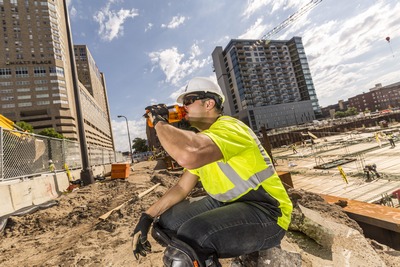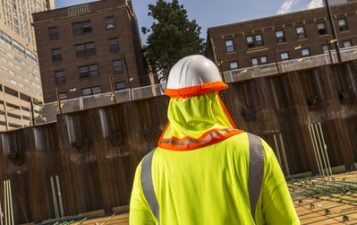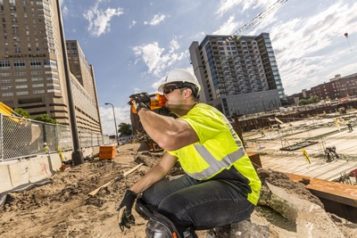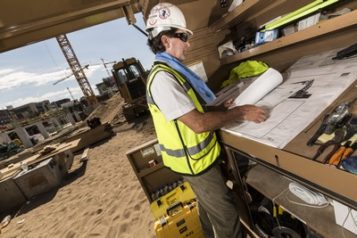
Changes in climate and weather patterns around the world are shattering records every day. Somewhere in our own backyard, today may be the driest, the wettest, the coldest… and the hottest. During the summer months, extreme heat is no stranger to many parts of the U.S. But even in the northern states, temperatures can rise dramatically, taking a toll on anyone, particularly those who make their living outside on construction sites. As a result, superintendents, foremen and project managers are using every opportunity to keep workers safe.
Some projects are inherently more challenging than others; for example, pouring hot asphalt or working on a multi-story building as heat rises.
“Here in Minnesota, we work year round in virtually every kind of weather scenario, so we aim to keep as cool when it’s 100 degrees as we try to stay warm when it’s below zero,” said Jay Vander Leest, director of safety for Kraus-Anderson Construction. “We are also aware that some construction workers think they can muscle through hot weather. That can be very dangerous, so we train our crews to look out for one another.”
While jobsite trailers often are equipped with air conditioning, work sites are not as lucky. Fans are used instead, which are helpful to keep air moving but may not keep body temperatures down. While obvious, the top precautions include drinking lots of water and taking ample breaks in the shade.
“We realize it is challenging to be productive when the temps – and the humidity – are dangerously high, so we just can’t overdo it,” said Vander Leest. “We also try to be very persistent and careful to notice signs of health problems. For example, one of the first things we look for is the absence of sweat. That’s because when it gets really hot and humid, perspiration is slowed, which can be a sign of trouble.”
Hot weather can bring three kinds of heat-related illnesses that need prompt attention: heat cramps, heat exhaustion and heat strokes.
Heat cramps
Heat cramps are muscle cramps. Usually these cramps occur in the arms or legs but may be in the abdominal or chest muscles as well. These cramps are caused by excessive body fluid loss through sweating. First aid includes moving the victim to a cool place, resting the cramping muscle and giving the person cool water.
Heat exhaustion
Heat exhaustion signs include heavy sweating, weakness, fast pulse, normal body temperature, headache and dizziness, nausea and vomiting. First aid for heat exhaustion requires the worker to be moved to a cool place. Keep them lying down with their legs straight and elevated 8-12 inches. Apply cold packs, wet towels or just wet their clothing to cool them. Give the victim cold water only if he or she is conscious. If the victim loses consciousness or if no improvement is noted within 30 minutes, seek medical attention.
Heat stroke
Heat stroke is a true emergency. Signs and symptoms include high body temperature, unconsciousness, hot skin, rapid pulse and breathing, weakness, dizziness or headache. Immediate first aid is required. Move the victim to a cool place and immediately cool the worker by any available means; for example, use ice and water from a jobsite cooler. Keep the head and shoulders slightly elevated. Monitor the airway and check to be sure the victim is breathing. Call for professional help or transport the heat stroke victim to a hospital immediately.
Rising temperatures and humidity levels not only plague the workers, but they also affect the types of equipment and materials used on a project. Sometimes decisions are made to work around or postpone using certain materials until weather conditions improve. For example, using adhesives, spray foams and some finishes that cannot cure in excessive conditions may have to be avoided. Also, working with hot materials on roofing and paving in the hot sun in large open spaces are other projects that may have to wait.
On the jobsite, productivity is always a priority. What type of materials do and do not work best in hot weather is important when maximizing efficiencies. But prevention of heat illness is paramount. Gradual adaptation to working in hot weather is a start.
As the weather heats up, take a few short breaks during the day and, if possible, schedule heavy work so that it does not have to be accomplished during the hottest part of the day. Dress sensibly and drink plenty of water. Keep a sharp eye out for potential heat injuries in workers. Try to practice prevention – it’s the name of the game – and it will keep workers from becoming a victim of a heat-related illness.
Rick Lund is general superintendent at Kraus-Anderson Construction. He can be reached at Rick.lund@krausanderson.com.
Photos courtesy of Ergodyne.





 Join our thriving community of 70,000+ superintendents and trade professionals on LinkedIn!
Join our thriving community of 70,000+ superintendents and trade professionals on LinkedIn! Search our job board for your next opportunity, or post an opening within your company.
Search our job board for your next opportunity, or post an opening within your company. Subscribe to our monthly
Construction Superintendent eNewsletter and stay current.
Subscribe to our monthly
Construction Superintendent eNewsletter and stay current.